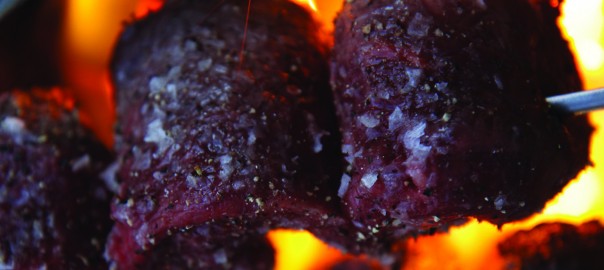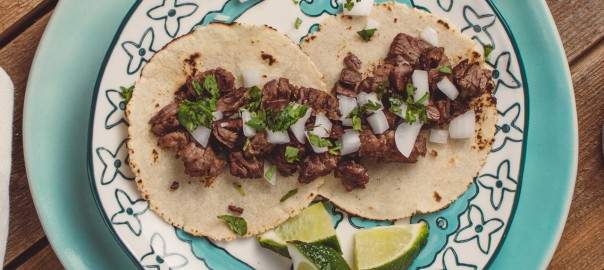A hidden delight of being a ButcherBox member is the monthly unpacking. As proof, check out one of the hundreds of videos people have posted online of them opening and discovering the cuts included in each month’s shipment.
One of the reasons the unboxing can be so exciting is that each month we include unique, difficult to find, and often underappreciated cuts of beef, pork, and chicken.
Some months, members may have come across a slab of beef that they’ve likely never seen at a butcher shop with a name they may not be familiar with: Coulotte, which is also commonly referred to as picanha, as well as fat cap, rump cap, or top sirloin cap by North American butchers.
This cut is derived from the triangular muscle of the top sirloin butt, also known as Biceps femoris. Coulotte is a lean steak that comes from this hindquarter section of the cow, specifically between the loin and the round. Often a couple of inches thick, picanha is usually identified by the thin layer of fat that covers one side of the cut. The fat layer gives the cut much of its flavoring as there is little marbling inherent in coulotte.
An international cut of beef
The name ‘coulotte’ itself has a bit of complicated backstory. There is some confusion over the derivation of the word from the original French. Some believe the word is closest related to ‘culot,’ meaning cap, a reference to the location and thin layer of fat of the top sirloin cut. However, there is also a belief that the name coulotte is derived from the French word ‘cul,’ meaning bottom or, to the dirtier-minded, is slang for the human derriere. This interpretation is taken from the French word’s relation to the Latin word ‘culus,’ meaning bottom, and refers to the location of the muscle in the cow’s hindquarters or backside.
To complicate matters further, another cut, the ribeye cap, which is very different steak altogether, is known in France as the ‘calotte,’ a name also related to the cap-like nature of that cut.
Most people are first introduced to the top sirloin cap by its Brazilian name, picanha, which is the specialty of churrascarias — Brazilian steakhouses that grill and slice the steak off a skewer. Churrascarias derive their name from the term churrasco, which is Portuguese for barbecue.
“Picanha, or coulotte, is hugely popular in Brazilian BBQ,” our in-house ButcherBox chef Yankel Polak said. “It is a perfect cut to grill.”
One thing is clear, when dry-seasoned and cooked carefully — do not overcook — the coulotte is a delicious steak. The cut is fantastic when cooked on a grill, but it is also has a lot of other uses, including for kabobs, steak sandwiches, stews, stir fry, shredded Mexican-style beef, and more.
Preparing coulotte/picanha
In the summer, you can grill picanha/coulotte on skewers, Brazilian churrasco-style, over a wood fire or on a charcoal grill. When grilling the steaks outdoors, first score the fat cap, cut into smaller steaks — against the grain — and then season generously with kosher salt or rock salt and fold and skewer. You can also cook directly on a grill; to do that right, first cook with the fat cap down for a few minutes.
Either way, whether you are in New York or California, grilled picanha will make you feel like you are in Rio de Janeiro in the summer.
“It’s crazy tender with a beautiful fat cap that just melts and crisps as you cook it,” he added. “Sliced thin and against the grain, this hunk of sirloin will literally melt in your mouth when treated properly, which is medium rare or skewered and slow roasted over an open fire.”
Chef Yankel loves a good mole. However, preparing the dish can be time-intensive. “Cheat the system by using mole-inspired flavors — peppers, nuts, spices, and chocolate — as a rub instead of a sauce,” he suggests. “Then top it all off with a spicy tomatillo salsa.”
Chef Yankel has a few delicious coulotte recipes to share. First, check out the video of him demonstrating his “Smoky Chili Rubbed Coulotte with Red Pepper Salsa” recipe in the video below and also find Chef Yankel’s “Mole-Rubbed Coulotte with Tomatillo Salsa” recipe after the video.
Chef Yankel’s recipe for Mole-Rubbed Coulotte (Picanha/Top Sirloin Cap) with Tomatillo Salsa
Servings: 4 Prep: 10 minutes Cook: 1½ hours
Ingredients:
- 1 ButcherBox Coulotte (Top Sirloin Cap)
- ½ tsp cinnamon
- 1 tsp cumin
- 2 Tbsp cocoa powder
- 1 Tbsp kosher salt
- ¼ cup pecan
- ¼ cup almond
- 1 dried ancho chili
- 1 dried chipotle chili
Tomatillo Salsa
- 6 tomatillo, husk removed and rinsed
- 1 poblano pepper
- 1 jalapeño pepper
- 1 serrano pepper
- 6 cloves garlic, roughly chopped
- 1 Tbsp lime juice
Directions:
1. In a food processor, combine kosher salt, cinnamon, cumin, garlic powder, cocoa powder, both chilies, and nuts.
2. Pulse until chilies and nuts are finely chopped.
3. Rub both sides of coulotte roast with the spice rub.
4. Refrigerate for 3 hrs or overnight.
5. Place coulotte on sheet pan and roast in 200℉ oven until internal temperature is 115℉.
6. Remove from oven and sear in a hot pan on all sides, 1½ min per side. Let rest for at least 8 min, then slice thinly against the grain.
Directions: Tomatillo Salsa
1. Toss tomatillos, garlic, and whole peppers in avocado oil.
2. Place on sheet pan and roast in a 400°F oven for 15 min or until tomatillos and peppers are browned from roasting.
3. Remove from the oven and place items in a mixing bowl, cover with plastic wrap and let sit for 15 min.
4. Remove the skin of the tomatillos and peppers and the seeds from the peppers.
5. Place tomatillos, peppers, garlic and the liquid from the mixing bowl in a food processor.
6. Add lime juice and puree.
7. Serve over the coulotte and enjoy!








